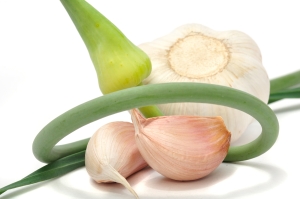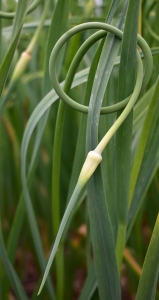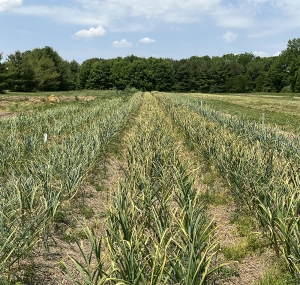Exploring the Versatility of Garlic Scapes
A Guide to Harvesting and Caring for Your Garlic Crop
 Garlic is a beloved ingredient in many culinary traditions, known for its pungent flavor and numerous health benefits. While most people are familiar with using garlic bulbs in their cooking, there’s another part of the garlic plant that deserves our attention – garlic scapes. These vibrant green shoots not only enhance the aesthetic appeal of garlic plants but also offer a unique taste and texture that can elevate any dish. In this blog post, we’ll delve into the world of garlic scapes, discussing when to harvest them, the different families of garlic, and essential care tips.
Garlic is a beloved ingredient in many culinary traditions, known for its pungent flavor and numerous health benefits. While most people are familiar with using garlic bulbs in their cooking, there’s another part of the garlic plant that deserves our attention – garlic scapes. These vibrant green shoots not only enhance the aesthetic appeal of garlic plants but also offer a unique taste and texture that can elevate any dish. In this blog post, we’ll delve into the world of garlic scapes, discussing when to harvest them, the different families of garlic, and essential care tips.
 When to Harvest Scapes:
When to Harvest Scapes:
Garlic scapes, also referred to as garlic stems or garlic tops, are the curly, flower-bearing stalks that emerge from hardneck garlic plants. The exact timing of scape emergence can vary depending on the garlic variety and local growing conditions, but generally, scapes start to appear in late spring or early summer.
To determine when to harvest scapes, it’s important to keep an eye on their growth. Scapes typically emerge once the garlic plant has developed several sets of leaves and the stalk reaches a height of around 10-15 inches. At this point, the scapes will form a tight curl or loop, making them easy to identify.
Families of Garlic and Harvest Order:
Garlic can be categorized into several families based on their characteristics and growth patterns. The order in which these garlic varieties typically develop scapes can vary, but here’s a general guideline:
-
Asiatics: Asiatic garlic varieties often have shorter, milder-flavored scapes and tend to be among the earliest to develop them.
-
Turbans: Turban garlic varieties may follow the Asiatics, producing scapes with a slightly stronger flavor profile.
-
Marbled Purple Stripe (MPS): MPS garlic varieties usually develop scapes after the Asiatics and Turbans. These scapes are known for their striking purple coloration and robust flavor.
-
Rocambole: Rocambole garlic varieties are renowned for their complex and rich flavor. Scapes from these plants tend to appear later than the previous families.
-
Porcelains: Porcelain garlic varieties typically have larger bulbs and scapes that emerge later in the season.
-
Silverskins: Silverskin garlic varieties are usually the last to produce scapes. These scapes are often more delicate in flavor and have a milder, nutty taste.

Green Leaves vs. Yellow Leaves:
When it comes to garlic leaves, their color can be a helpful indicator of the plant’s health and maturity. While green leaves indicate a thriving and vigorous plant, yellowing leaves may suggest that the garlic bulbs are nearing maturity. As the bulbs mature, the plant starts redirecting its energy from leaf production to bulb development, resulting in the yellowing of leaves.
Timing for Feeding and Watering:
Once garlic scapes have appeared, it’s generally recommended to cease fertilizing the plants. This helps the garlic bulbs focus on maturing rather than continuing to produce foliage. However, it’s important to note that garlic scapes are still actively growing during this time, so it’s crucial to ensure they receive adequate nutrients from the soil prior to stopping feeding.As for watering, garlic plants require consistent moisture during their growth cycle. It’s advisable to provide regular watering until a few weeks after scapes appear. At this point, reducing the amount of watering can help the bulbs develop their characteristic flavors and improve their storage potential.





